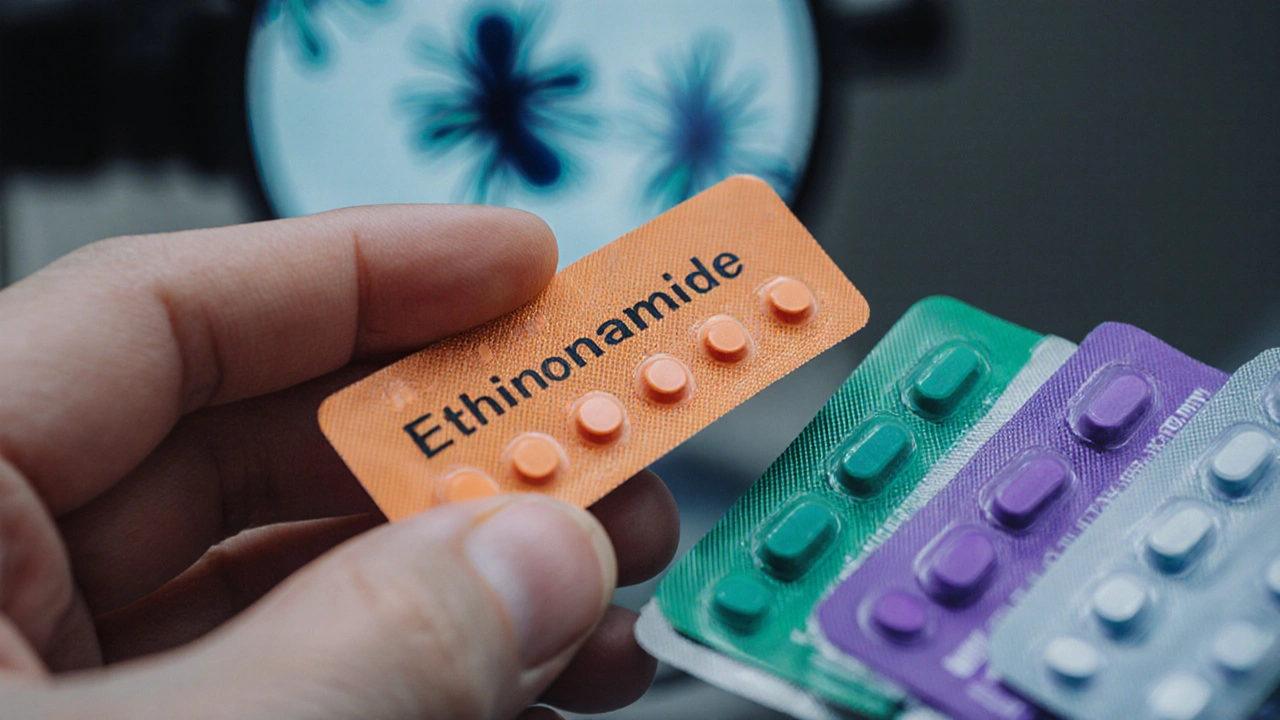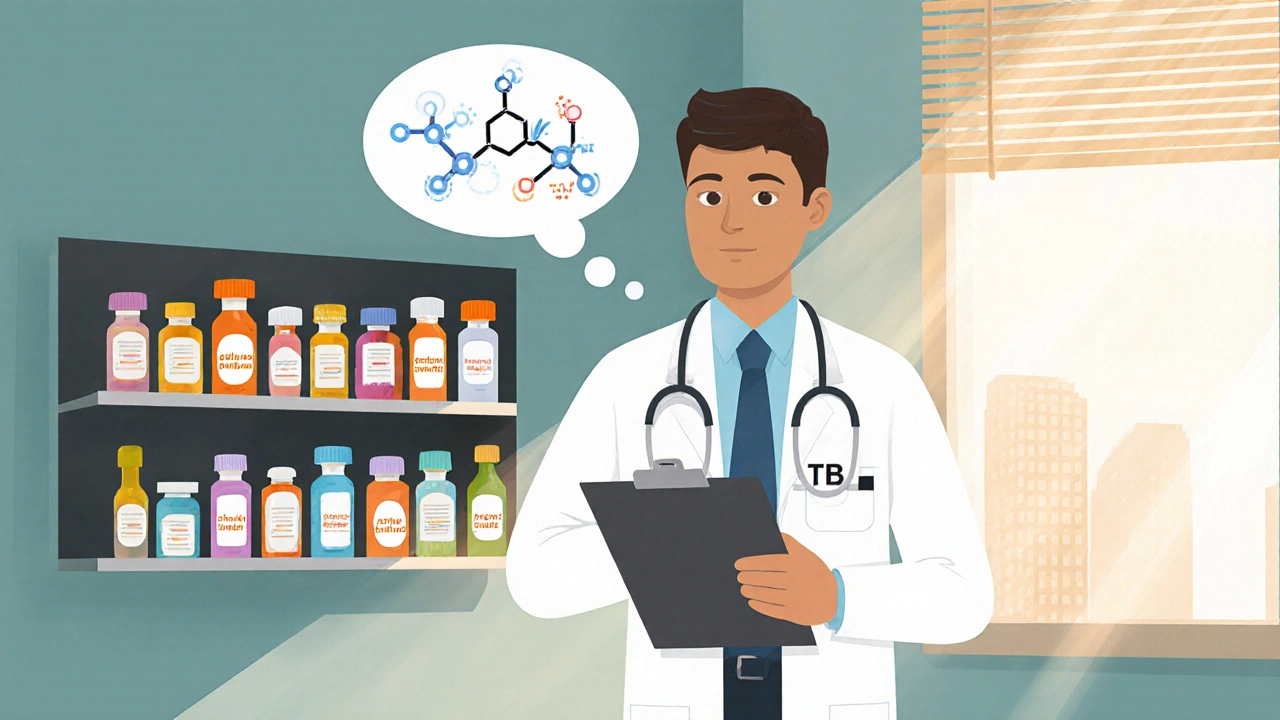MDR-TB Drug Selection Advisor
Select Patient Factors
Recommended Drug(s):
When doctors treat tuberculosis (TB), especially drug‑resistant forms, they have to pick from a handful of second‑line medicines. Trecator SC is the brand name for Ethionamide, a synthetic antibiotic that targets the bacterial cell wall of Mycobacterium tuberculosis. It’s often reserved for multi‑drug‑resistant TB (MDR‑TB) when first‑line drugs like isoniazid and rifampicin can’t do the job.
Quick Take
- Ethionamide works by inhibiting the synthesis of mycolic acids, a key component of the TB bacterium’s cell wall.
- Typical dose is 15‑20mg/kg daily, taken on an empty stomach for better absorption.
- Common side effects include nausea, vomiting, and peripheral neuropathy; severe hepatotoxicity is rare but possible.
- Alternatives such as Bedaquiline and Delamanid have newer mechanisms and shorter treatment periods.
- Choosing the right drug depends on resistance profile, side‑effect tolerance, and how the medication fits into a patient’s overall regimen.
Why Ethionamide Still Matters
Even though newer agents like bedaquiline have entered the market, ethionamide remains a staple for several reasons:
- Broad activity against resistant strains. It retains potency where many first‑line drugs fail.
- Affordable. In many low‑ and middle‑income countries, ethionamide is cheaper than newer compounds.
- Established dosing guidelines. Decades of experience give clinicians clear expectations for monitoring.
However, the drug’s biggest drawback is its gastrointestinal toxicity and the risk of peripheral neuropathy, especially when combined with other neurotoxic agents.
Key Alternatives to Compare
Below is a snapshot of the most commonly used second‑line TB drugs that clinicians consider alongside ethionamide. Each entry is introduced with microdata for easy knowledge‑graph extraction.
Isoniazid - a first‑line agent that inhibits mycolic acid synthesis, still useful in low‑level resistance scenarios. Rifampicin - another first‑line drug targeting RNA polymerase; often paired with ethionamide in MDR‑TB regimens. Bedaquiline - a diarylquinoline that blocks ATP synthase, shortening treatment from 24‑30 months to about 9‑12 months. Delamanid - a nitro‑imidazooxazole that inhibits mycolic acid synthesis, approved for MDR‑TB with a favorable safety profile. Levofloxacin - a fluoroquinolone that interferes with DNA gyrase, often part of combination therapy. Cycloserine - a cyclic amino acid that inhibits cell‑wall peptidoglycan formation, known for neuropsychiatric side effects. Linezolid - an oxazolidinone that blocks protein synthesis, highly effective but can cause bone‑marrow suppression.Side‑by‑Side Comparison Table
| Drug | Mechanism | Typical Use (MDR‑TB) | Common Side Effects | Dosing Frequency |
|---|---|---|---|---|
| Ethionamide | Inhibits mycolic‑acid synthesis (similar to isoniazid) | Second‑line, when resistance to isoniazid/rifampicin confirmed | Nausea, vomiting, peripheral neuropathy, hepatotoxicity | Once daily (empty stomach) |
| Bedaquiline | Blocks ATP synthase | Core drug for MDR‑TB; often combined with fluoroquinolones | QT prolongation, hepatotoxicity | Loading dose then three times weekly |
| Delamanid | Inhibits mycolic‑acid synthesis via a different pathway | Alternative to bedaquiline; used when QT risk high | QT prolongation, nausea | Twice daily |
| Levofloxacin | Inhibits DNA gyrase | Often part of combination regimens | Tendonitis, QT prolongation, GI upset | Once daily |
| Cycloserine | Inhibits cell‑wall peptidoglycan formation | Adjunct for MDR‑TB when other options limited | Depression, seizures, GI upset | Twice daily |
| Linezolid | Blocks protein synthesis (50S ribosomal subunit) | Highly active against XDR‑TB | Myelosuppression, peripheral neuropathy, optic neuritis | Twice daily |

How to Choose the Right Drug for a Patient
Picking a regimen isn’t just about which drug is “newer.” Clinicians weigh three main factors:
- Resistance profile. Culture and sensitivity tests pinpoint which agents the strain survives.
- Side‑effect tolerance. Patients with pre‑existing liver disease may avoid ethionamide or bedaquiline.
- Drug‑interaction landscape. For example, rifampicin induces CYP450 enzymes, lowering ethionamide levels.
Below is a quick decision‑tree you can sketch on a clipboard:
- Confirm MDR‑TB (resistance to isoniazid+rifampicin).
- Check for QT‑interval issues - if present, skip bedaquiline/delamanid.
- Assess liver function - severe impairment suggests avoiding ethionamide and bedaquiline.
- Consider neuro‑psychiatric history - avoid cycloserine if depression is a concern.
- Finalize regimen with at least four active drugs, rotating between oral and injectable if needed.
Managing Ethionamide’s Side Effects
Patients on Trecator SC often ask how to handle the notorious nausea. Here are practical tips that clinicians have found effective:
- Take with food. Although fasting improves absorption, a light snack can blunt the stomach upset.
- Vitamin B6 (pyridoxine) supplementation. Helps prevent peripheral neuropathy, especially when combined with isoniazid.
- Regular liver‑function monitoring. Check ALT/AST at baseline and every two weeks during the first two months.
- Adjust dose for weight‑gain patients. Ethionamide’s pharmacokinetics are weight‑dependent; a 10% weight increase may warrant a dose tweak.
If hepatotoxicity spikes beyond three times the upper limit of normal, clinicians should pause ethionamide and consider swapping in delamanid or linezolid.
Cost and Accessibility Snapshot
In many parts of Asia, Africa, and South America, ethionamide costs roughly US$0.10 per 250mg tablet, making a full‑course (often 24 months) under US$600. In contrast, bedaquiline’s price can exceed US$30,000 for a standard regimen, limiting its use to well‑funded programs.
Public health programs like the WHO’s “End TB Strategy” still list ethionamide as a core second‑line drug precisely because it balances efficacy with affordability.
Key Takeaways
- Ethionamide remains a workhorse for MDR‑TB, especially where budgets are tight.
- Newer agents (bedaquiline, delamanid) offer shorter treatment and fewer GI issues, but they bring cardiac monitoring needs and higher costs.
- Side‑effect management-particularly GI tolerance and neuropathy-can keep patients on ethionamide longer and improve cure rates.
- Choosing the right drug hinges on resistance patterns, organ‑function status, and program funding.
Frequently Asked Questions
What is the main advantage of ethionamide over newer drugs?
Its low cost and long history of use make it accessible in low‑resource settings, where newer drugs may be unavailable or unaffordable.
Can ethionamide be used together with rifampicin?
Yes, but clinicians must monitor liver enzymes closely because rifampicin can increase the metabolic clearance of ethionamide, potentially reducing its effectiveness.
How long does a typical ethionamide‑based regimen last?
For MDR‑TB, treatment usually lasts 18‑24months, with ethionamide taken throughout the intensive phase and often continued into the continuation phase.
What monitoring is required for patients on ethionamide?
Baseline liver function tests, monthly ALT/AST checks for the first two months, and periodic neurologic exams for signs of peripheral neuropathy. Vitamin B6 supplementation is recommended.
Is ethionamide safe for pregnant women?
Animal studies suggest possible teratogenicity, so it is generally avoided unless the benefits outweigh the risks. Alternatives like linezolid are also used with caution.
What should a patient do if they experience severe nausea?
Report the symptom immediately. The clinician may split the dose, give anti‑emetics, or switch to a different second‑line drug if nausea persists despite supportive measures.


Dominic Dale
Ever notice how the pharmaceutical giants love to push the newest, flashier TB drugs like bedaquiline and delamanid while quietly keeping older, cheaper options like ethionamide on the back‑burner? It isn’t just about efficacy; it’s about the deep pockets they can tap into when you prescribe a $30,000 regimen instead of a $600 one. The data on ethionamide’s side‑effects are out there, but they’re buried under layers of glossy marketing that glorify the novel mechanisms of the newer agents. Meanwhile, the WHO’s “core second‑line” list keeps ethionamide in the spotlight, which is a clue that there’s more than pure science at work. Governments in low‑ and middle‑income countries are often pressured into buying the expensive drugs because the contracts are tied to aid packages that favor big pharma. If you look at the timelines, every time a new TB drug gets a blockbuster label, the sales of ethionamide dip, and suddenly the supply chain for it gets “unstable.” That isn’t coincidence; it’s a coordinated effort to shift the market. The cheap tablets are produced in factories with older equipment, and any quality‑control hiccup is framed as a “risk” to patients, pushing clinicians toward the “safer” high‑cost alternatives. Some whistleblowers have hinted at undisclosed payments to health officials in exchange for preferential procurement, and the pattern repeats across continents. It’s also telling that the side‑effect profile of ethionamide-nausea, peripheral neuropathy-is always downplayed in the literature, while the QT‑prolongation risk of bedaquiline is highlighted as a serious warning. This selective emphasis steers prescribing habits subtly. The clinical guidelines themselves are written by committees that receive consulting fees from the manufacturers of the newer drugs, creating an echo chamber where the old drugs are framed as “legacy” and thus less desirable. All of this builds a narrative that newer equals better, even when head‑to‑head trials show comparable cure rates for certain MDR‑TB strains. The bottom line is that the push for newer, pricier TB drugs isn’t just about therapeutic progress; it’s a carefully engineered economic engine that keeps the old, affordable drugs like ethionamide on the margins. So next time you read a glossy article praising the latest TB breakthrough, ask yourself who’s paying the bill and who stands to lose.